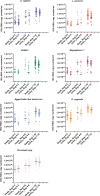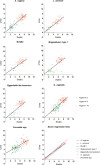Bacterial vaginosis diagnosed by analysis of first-void-urine specimens
- PMID: 24197876
- PMCID: PMC3911461
- DOI: 10.1128/JCM.02347-13
Bacterial vaginosis diagnosed by analysis of first-void-urine specimens
Abstract
Bacterial vaginosis (BV) is traditionally diagnosed using vaginal samples. The aim of this study was to investigate whether BV can be diagnosed from first-void urine (FVU). Self-collected vaginal smears, vaginal swabs, and FVU were obtained from 176 women. BV was diagnosed by Nugent's criteria. The FVU and vaginal swabs were analyzed by quantitative PCRs (qPCRs) for selected vaginal bacteria (Atopobium vaginae, Prevotella spp., Gardnerella vaginalis, bacterial vaginosis-associated bacterium 2, Eggerthella-like bacterium, "Leptotrichia amnionii," Megasphaera type 1), and all had an area under the receiver operating characteristic (ROC) curve of >85%, suggesting good prediction of BV according to the Nugent score. All seven bacteria in FVU were significantly associated with BV in univariate analysis. An accurate diagnosis of BV from urine was obtained in this population by a combination of qPCRs for Megasphaera type 1 and Prevotella spp. The same two bacteria remained significantly associated with BV in a multivariate model after adjusting for the other five species. There was no statistically significant difference between the sensitivities and specificities of BV diagnosis by molecular methods performed on swabs and FVU samples. A linear regression analysis showed good agreement between bacterial loads from swabs and FVU, but Prevotella spp. could be detected in high numbers in a few FVU samples without being present in swabs. This method will allow diagnosis of BV in studies where only urine has been collected and where detection of BV is considered relevant.
Figures



References
-
- Amsel R, Totten PA, Spiegel CA, Chen KC, Eschenbach D, Holmes KK. 1983. Nonspecific vaginitis. Diagnostic criteria and microbial and epidemiologic associations. Am. J. Med. 74:14–22 - PubMed
Publication types
MeSH terms
LinkOut - more resources
Full Text Sources
Other Literature Sources
Medical
Molecular Biology Databases
Miscellaneous

